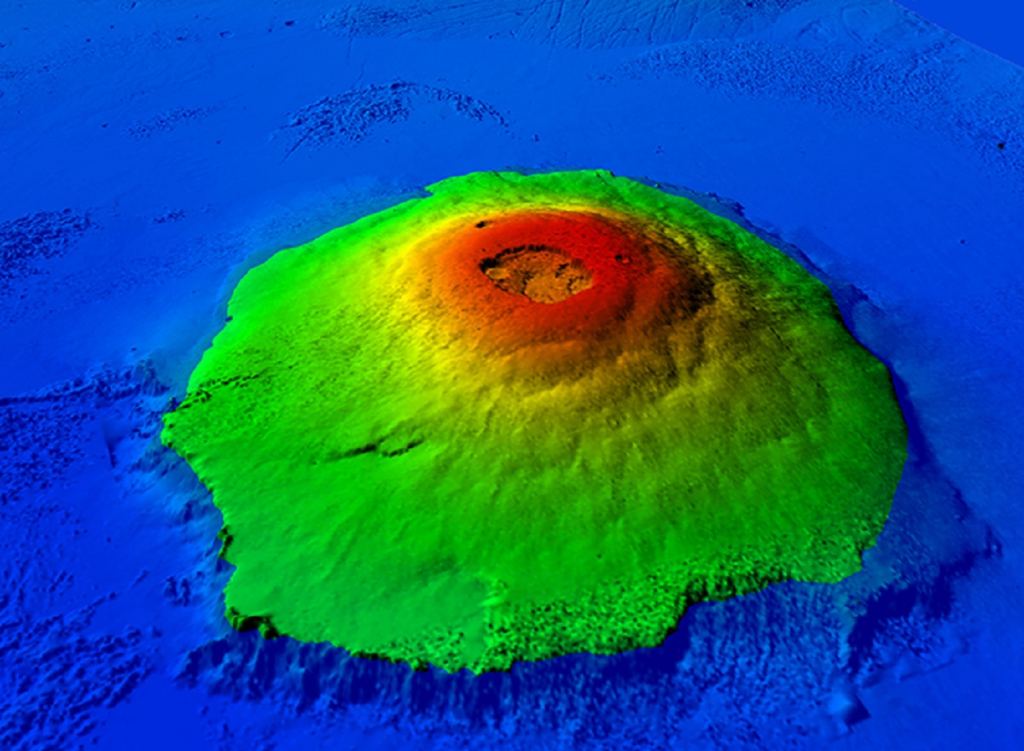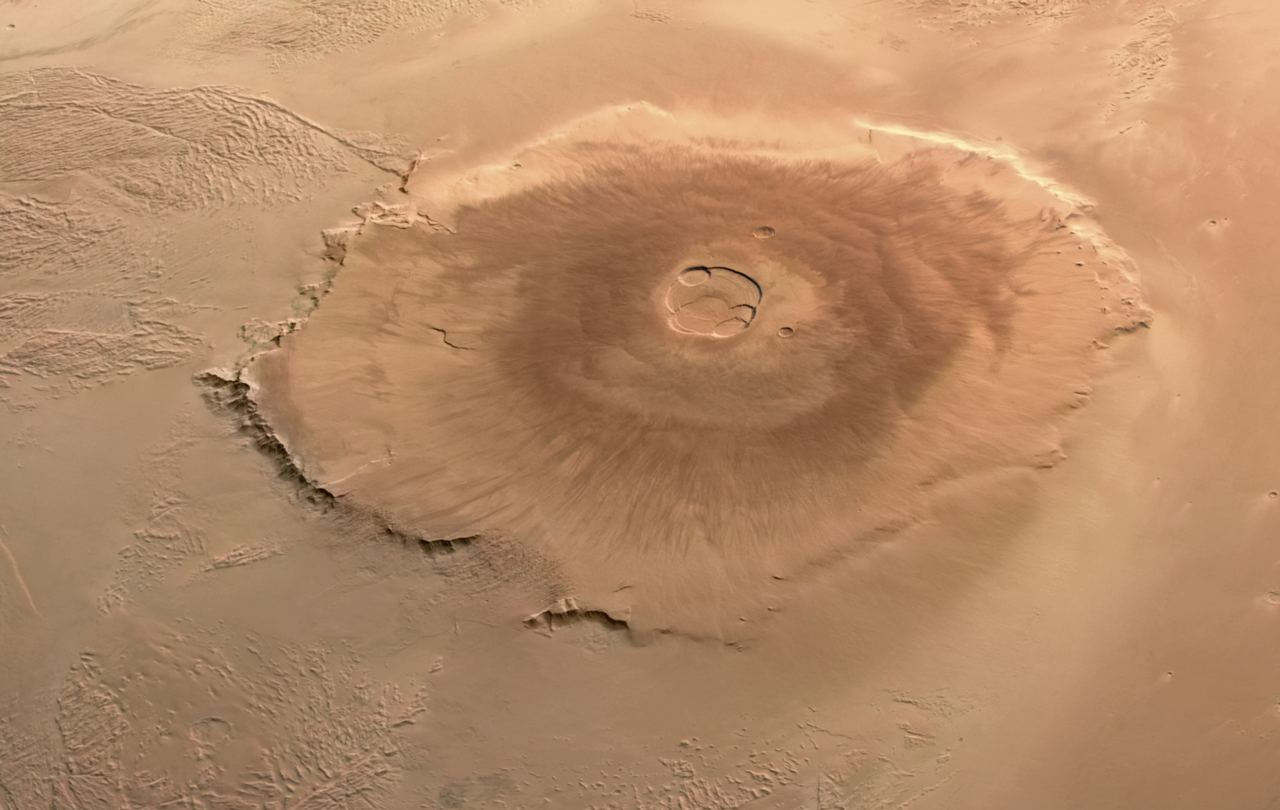Olympus Mons, located at the northwest edge of the Tharsis Montes region on Mars, was appropriately named. Based on readings obtained by the Mars Orbiter Laser Altimeter (MOLA), an instrument aboard NASA’s Mars Global Surveyor (MGS), this mountain is the tallest in the Solar System, standing 21.9 km (13.6 mi) tall – about two and a half times the height of Mount Everest (8.85 km; 5.5 mi). According to current estimates, this extinct shield volcano formed during Mars’ Hesperian Period (ca. 3.7 to 3 billion years ago), which was characterized by widespread volcanic activity and catastrophic flooding.
This coincides with a period when Mars had a denser atmosphere, a warmer environment, and flowing water on its surface. This included a global ocean that spanned much of the northern hemisphere, known today as the Northern Lowlands, encompassing Olympus Mons. According to a recent study led by researchers from the Centre National de Recherches Scientifique (CNRS), features found on the slopes of Olympus Mons indicate that it could have been a massive volcanic island where volcanic eruptions flowed into the ocean, similar to ones found on Earth.
The research was conducted by a team of CNRS researchers with the Geosciences Paris-Saclay Laboratory (GEOPS) at the Unversity of Paris-Saclay. The team was led by Anthony Hildenbrand, a CNRS GEOPS researcher, with the assistance of Fernando Ornelas Marques, a geology professor at the Universidade de Lisboa. The paper that describes their findings – “A giant volcanic island in an early Martian Ocean?” – recently appeared in the Earth and Planetary Science Letters.

As Hildenbrand related to Universe Today via email, knowing when, where, and how long flowing water existed on Mars is crucial to astrobiology studies on the Red Planet.”No one really knows how long early liquid water may have existed at the surface of Mars, which potentially has important implications regarding the fate of early life on Mars and in the Solar System,” he said. According to the geological record, life began on Earth roughly 4 billion years ago when much of the surface was covered in water, and the atmosphere was largely the result of volcanic outgassing.
This ancient atmosphere is similar to what we see on Mars today, which is predominantly composed of carbon dioxide (95%) with trace amounts of nitrogen, argon, oxygen, and minute amounts of water vapor. While the Martian atmosphere was once thicker and able to absorb more heat, it began being stripped away by solar wind once the planet’s global magnetic field disappeared (ca. 4.2 to 3.7 billion years ago). Essentially, by knowing how long Mars maintained a warmer, water environment, astrobiologists hope to determine if the window for the emergence of life was large enough.
For their study, the team analyzed features on the slopes of Olympus Mond and the elevated shorelines of the Tharsis Montes volcanic region. They then compared these to similar features found on volcanoes here on Earth that formed from the interaction of magma and water. Said Hildenbrand, these included “[m]orphological similarities with active volcanic islands on Earth, which show a significant constructional slope break at shore level, due to a drastic increase in lava viscosity during cooling in the presence of liquid water.”
For decades, astronomers and astrogeologists have considered the Tharsis Montes (or Tharsis Bulge) region as an anomaly. While the feature has poorly defined boundaries, it measures about 5,000 km (3,100 mi) in diameter and up to 7 km (4.3 mi) in height. The most widely-held view is that this region sits atop a volcanic “hotspot” created by one or more columns of hot magma rising through the mantle – similar to the islands of Hawaii and other hotspots in the Pacific. Since Mars has no tectonic plates, this led to the build-up of magma over time, resulting in a massive volcanic outburst.

While considerable research has been dedicated to studying Tharsis and its volcanic “shorelines,” the possible relation to past sea levels has been previously overlooked. As Hildebrand said:
“The volcanic shorelines proposed in our paper may be an unambiguous witness for past sea level, where research for traces of early life (organic matter) could be targeted. More generally speaking, knowing where and when past Martian oceans may have been has significant implications for climatic models, because this would give decisive constraints on the initial amount of stable liquid water, the physical conditions for the persistence of a stable atmosphere, until when magmatic degassing associated with major planet activity may have occurred.”
Based on their findings, Hildebrand and his team theorize that the upper rim of the 6 km (3.7 mi)-high main escarpment surrounding Olympus Mons was likely formed during the late Noachian to early Hesperian (ca. 3.8 to 3.5 billion years ago) by lava flowing into liquid water. This is bolstered by similar features observed on the northern flank of Alba Mons, located 1,800 km (1,120 mi) northwest of Olympus Mons. This elliptically-shaped volcanic feature has a maximum height of 6.8 km (4.2 mi), roughly one-third the height of Olympus Mons, but with far gentler slopes and a much wider base.
These findings suggest that the ocean occupying the Northern Lowlands on Mars existed for an extended period of time. The team further concluded that at some point during the Hesperian (ca. 3.7 to 3.0 billion years ago), there was a major surface uplift caused by internal dynamics. This is what led to the current shoreline around Olympus Mond sanding abnormally high – 6 km (3.7 mi) above the surrounding Lowlands. Lastly, they condluced that after the oceans retreated during the Amazonian period (ca, 3 billion years ago to today), these shortlines were partly blanketed by sub-aerial eruptions.
These findings could lead to tighter constraints on how long Mars had surface water, and also provide additional clues as to how long geological activity lasted on the planet. While scientists suspected that Mars was geologically dead, recent evidence provided by NASA’s InSight lander has shown that there is still some activity in its interior. Since volcanism and geological activity have played an active role in the evolution of life on Earth (and possibly the emergence of it), knowing how long such activity last on Mars could also be key to finding evidence of past life. Said Hildebrand:
“The volcanic shorelines here proposed are targets of particular interest to put an absolute age (though radiometric dating) on sea level(s) on Mars, which would enable quantitative reconstructions of oceans evolution early in the history of Mars. Yet, the relative chronology of the various surfaces and landforms is based on crater-counting with very large age uncertainties (by up to hundreds millions years).”
Further Reading: CNRS, Earth and Planetary Science Letters


Nit: “this mountain is the tallest in the Solar System, standing 21.9 km (13.6 mi) tall”.
Possibly, but the central peak of Vesta’s Rheasilvia impact crater is estimated as standing 22.5 km from its base.